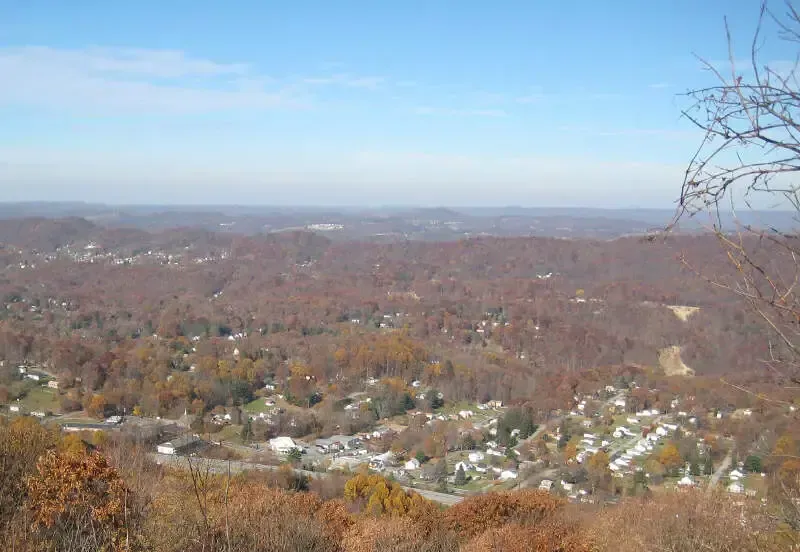Nestled in the mountainous heart of West Virginia, Bluefield once pulsated with the energy of a coal-fueled boomtown. Its streets, teeming with miners and merchants, echoed with the promise of a prosperous future. But like a flame extinguished by a mine shaft’s darkness, Bluefield’s golden age has faded, leaving behind a stark reality that has earned it the dubious title of West Virginia’s “worst city to live.” This article delves into the story of Bluefield, exploring its rise and fall, the factors contributing to its current predicament, and the glimmer of hope that still flickers within its boundaries.
Source – roadsnacks
I. A Coal-Fueled Boom:
The year is 1890. Bluefield, a quiet mountain town with a population of barely 2,000, witnesses a discovery that changes its destiny. Coal, the black gold of the era, is found in abundance beneath its rugged hills. The town erupts in a frenzy of activity. Miners arrive, drawn by the promise of wealth, and businesses sprout like mushrooms after rain. By 1940, the population explodes to over 20,000, transforming Bluefield into a bustling metropolis. Grand hotels, ornate theaters, and sprawling coal mines become the town’s new landmarks, testament to the power of a single discovery.
II. The Tide Turns:
However, the coal boom, like all good things, eventually comes to an end. The mines begin to deplete, automation replaces manual labor, and the industry shifts to greener pastures. Bluefield, once a shining star, finds itself shrouded in the dust of a bygone era. The jobs disappear, businesses shutter, and the exodus begins. The population plummets, dropping to a mere 9,619 by 2020, leaving behind a hollow shell of its former self.
III. The Grim Reality:
The legacy of the coal boom casts a long shadow on present-day Bluefield. The unemployment rate, a staggering 6.4%, paints a grim picture of economic hardship. The median income, at $45,854, barely surpasses the national poverty line, highlighting the struggle for basic necessities. Crime, though not statistically high, becomes amplified in a shrinking community, creating a sense of unease and insecurity.
IV. Beyond the Shadows:
Despite the bleakness, Bluefield is not without its glimmers of hope. The spirit of resilience, ingrained in the hearts of its people, refuses to be extinguished. Local initiatives, such as arts and culture programs, aim to revitalize the town’s downtown and attract new businesses. The stunning natural beauty of the surrounding mountains offers opportunities for tourism and outdoor recreation. Additionally, the relatively affordable housing market presents a potential draw for young entrepreneurs and those seeking a simpler way of life.
FAQ’s:
Is Bluefield really the worst city to live in West Virginia?
Roadsnacks named Bluefield the “worst city to live” based on factors like population decline, high unemployment, and low median income. However, it’s important to remember that every city has its own unique story and what constitutes “worst” can be subjective. While Bluefield faces challenges, it also offers a lower cost of living, stunning natural beauty, and a community spirit that shouldn’t be discounted.
What happened to Bluefield’s economy?
Bluefield’s economy was heavily reliant on the coal industry. As coal mining declined, jobs disappeared, leading to population loss and economic hardship. While efforts are underway to diversify the economy, the transition remains challenging.
Is Bluefield dangerous?
The crime rate in Bluefield is lower than the national average. However, like any other community, it’s important to be vigilant and take precautions, especially in less-populated areas.
What is the job market like in Bluefield?
The unemployment rate in Bluefield is higher than the national average, and job opportunities are limited. However, there are growing sectors like healthcare, education, and tourism that offer some potential.
Conclusion:
Bluefield’s story serves as a poignant reminder of the cyclical nature of economic prosperity. It is a cautionary tale of the dangers of overreliance on a single industry and a testament to the human cost of industrial decline. Yet, amidst the hardship, there lies a flicker of hope, fueled by the unwavering spirit of its residents and the potential for reinvention. Whether Bluefield can rise from the ashes of its coal-fueled past remains to be seen. But one thing is certain: its story is far from over, and its future, like the veins of coal that once ran through its mountains, holds the potential for something new and unexpected.
Disclaimer:
The information presented in this article and FAQs about Bluefield, West Virginia, is based on publicly available data and resources, including reports, statistics, and news articles. While we strive to provide accurate and up-to-date information, we cannot guarantee its comprehensiveness or absolute accuracy.
Furthermore, the opinions and assessments expressed in this content are based on subjective interpretations of available data and should not be construed as professional advice. We encourage individuals considering life in Bluefield to conduct their own thorough research and consult with relevant professionals such as financial advisors, real estate agents, and community members before making any decisions.
Finally, it’s important to remember that economic and social conditions can change rapidly. While this content reflects the current situation in Bluefield to the best of our knowledge, the future remains uncertain, and potential positive or negative developments should be factored into any conclusions drawn.

